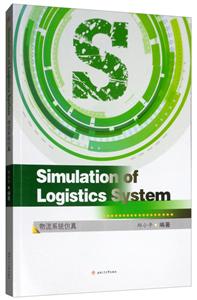-
>
营销管理
-
>
茶叶里的全球贸易史(精装)
-
>
近代华商股票市场制度与实践(1872—1937)
-
>
麦肯锡图表工作法
-
>
底层逻辑:看清这个世界的底牌
-
>
李诞脱口秀工作手册
-
>
成事:冯唐品读曾国藩嘉言钞
物流系统仿真 版权信息
- ISBN:9787564362263
- 条形码:9787564362263 ; 978-7-5643-6226-3
- 装帧:一般胶版纸
- 册数:暂无
- 重量:暂无
- 所属分类:>>
物流系统仿真 内容简介
Simulation is one of the most important methods utilizing models to study system.Simulation technology has developed for nearly 50 years. It has been applied widelyand effectively in aerospace, military, automation, electric power and other fields. Withthe development of computer technology and in-depth research in all areas, systemsimulation technology is becoming more and more mature and its application fields areexpanding. Recently, more and more people are paying attention to modern logistics. It hasmany features, including wide coverage, comprehensiveness and broad involvement. Itcovers industry, agriculture and service industry, and it integrates a number of areas inmanagement and engineering. It involves many processes such as transportation,warehousing, packaging, service, information, and so on. Logistics is not only related to the enterprises' development, but also plays a vital role in the development of the national economy. Therefore, people pursue the common goal of promoting the transformation from traditional logistics to modern logistics. The research on introducing system simulation technology into modern logistics can assist people to scientifically plan and design logistics systems, control logistics operation process, and allocate logistics resources. It can promote the overall optimization of logistics system. At the same time, the vigorous development of the logistics industry will also promote the development of system simulation technology and open up a new field for the application of system simulation.
物流系统仿真 目录
1.1 Systems and System Model
1.2 System Simulation Outline
1.3 The Characteristics of System Simulation
1.4 Logistics System Simulation and Technology
1.5 Trend of System Simulation
Chapter 2 Basic Knowledge of System Simulation
2.1 The Continuous System and Discrete System
2.2 Discrete Event System Simulation Method
2.3 Queuing System
2.4 Inventory System
2.5 Single-channel Queuing System Simulation
2.6 Single-item Inventory System Simulation
Chapter 3 Random-Number and Random-Variable
3.1 Deterministic System and Random System
3.2 Random-number and Random-variable
3.3 Random-number Generation
3.4 Tests for Random Numbers
3.5 Random-variable Generation
Chapter 4 Processing of Input Modeling
4.1 Overview of Input Modeling
4.2 Data Collection and Data Processing
4.3 Assumptions of Data Distribution
4.4 Parameter Estimation
4.5 Goodness-of-Fit Test
Chapter 5 Methodologies of Discrete Event Simulation
5.1 Event Scheduling
5.2 Activity Scanning
5.3 Process Interaction
Chapter 6 Output Analysis of System Simulation
6.1 Introduction
6.2 Types of System Simulation
6.3 Interval Estimation and Confidence Intervals
6.4 Output Analysis of Termination-type Simulation
6.5 Output Analysis of Steady-state Simulation
6.6 Comparison of Random Varibles
6.7 Sensitivity Analysis
6.8 Orthogonal Design
6.9 Parameter Optimization
Chapter 7 Introduction and Installing of Anylogic
7.1 Introduction of Anylogic
7.2 Installing of Anylogic
Chapter 8 Agent Based Modeling with Anylogic
8.1 Market Model
8.2 Creating the Agent Population
8.3 Defining a Consumer Behavior
8.4 Adding A Chart to Visualize the Model Output
8.5 Adding Word of Mouth Effect
8.6 Considering Product Discards
8.7 Considering Delivery Time
8.8 Simulating Consumer Impatience
8.9 Comparing Model Runs with Different Parameter Values
Chapter 9 Discrete-event Modeling with AnyLogic
9.1 Job Shop Model
9.2 Creating A Simple Model
9.3 Adding Resources
9.4 Creating 3D Animation
9.5 Modeling Pallet Delivery by Trucks
9.6 Modeling CNC Machines
Chapter 10 System Dynamics Modeling with AnyLogic
10.1 Creating a Stock and Flow Diagram
10.2 Adding A Plot to Visualize Dynamics
10.3 Parameter Variation Experiment
Main Reference
物流系统仿真 作者简介
邱小平,男,博士后,西南交通大学交通运输与物流学院教授。2004年6月在西南交通大学获交通信息工程及控制专业工学博士学位,后在西南交通大学管理科学与工程博士后流动站工作
- >
李白与唐代文化
李白与唐代文化
¥12.2¥29.8 - >
小考拉的故事-套装共3册
小考拉的故事-套装共3册
¥36.7¥68.0 - >
上帝之肋:男人的真实旅程
上帝之肋:男人的真实旅程
¥19.3¥35.0 - >
诗经-先民的歌唱
诗经-先民的歌唱
¥19.9¥39.8 - >
中国历史的瞬间
中国历史的瞬间
¥16.7¥38.0 - >
莉莉和章鱼
莉莉和章鱼
¥21.0¥42.0 - >
朝闻道
朝闻道
¥8.8¥23.8 - >
二体千字文
二体千字文
¥22.4¥40.0





















